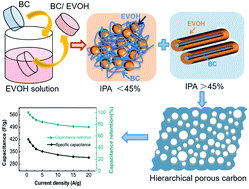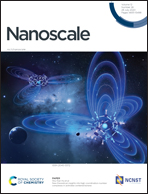Controlled preparation of interconnected 3D hierarchical porous carbons from bacterial cellulose-based composite monoliths for supercapacitors†
Abstract
The controlled design and synthesis of porous carbons with anticipated microstructures and morphologies, and a high specific surface area (SSA) have been focused on for supercapacitor development. Here, hierarchical porous carbons (HPCs) with an interconnected three-dimensional morphology derived from a natural-based bacterial cellulose (BC) composite have been successfully prepared by thermally induced phase separation of poly(ethylene-co-vinyl alcohol) (EVOH) and subsequent carbonization/activation. The SSA and porous architectures can be controlled by fine-tuning the preparation conditions such as the precursor morphology and structure, activator dosage and activation temperature, and the relationships between the super-capacitive properties and the SSA and pore size distribution have been further investigated. The obtained porous carbon material possesses a hierarchical porous structure with moderate micropores, favorable mesopores, interconnected macropores, a high SSA of 2161 m2 g−1 and a maximum oxygen-dopant content of 9.99%, enabling an increase in the active materials utilization efficiency and wettability. Due to the synergistic effects of these features, the obtained porous carbon electrode used in a supercapacitor shows a high specific capacitance of 420 F g−1 at 0.5 A g−1, excellent rate performance with 75% capacitance retention at 20 A g−1, and good cycling stability with ∼96.1% retention even after 10 000 continuous charge–discharge cycles at 5 A g−1. Additionally, the assembled supercapacitor based on porous carbon displays a moderate energy density of 20 W h kg−1. The good electrochemical performance and facile effective synthesis of bio-derived carbon materials with tunable porous structures indicate promising applications in supercapacitors.



 Please wait while we load your content...
Please wait while we load your content...